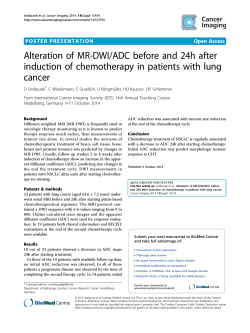
Slide 0 - Imedex
Optimal Sequence of Therapies for Advanced GI Neuroendocrine Tumors (NET) Tim Hobday M.D. Mayo Clinic Rochester, MN Disclosure • Research funding: Novartis Off-label therapy discussed • Octreotide for PNET • Temozolomide and capecitabine for PNET • Targeted therapy for carcinoid tumors • Combined targeted therapies for PNET What is the Scenario? • Grade 1-2 NET with dominant hepatic metastases • Progressive tumor • Symptoms, or impending symptoms, of tumor bulk and/or endocrine syndrome despite Octreotide • Not a candidate for hepatic resection Rationale for Liver-Targeted Therapy • “Selective” hepatic arterial blood supply to metastases • “Concentrate” chemotherapy • “Selective” internal radiotherapy • “Less toxic, more effective” than systemic therapy • Indolent disease: embolic therapies may take 3-5 months to complete HEPATIC RESECTIONS Surgical control of sx Recurrence of sx in 5 yrs 104/108 59 % (median 45.5 mos) Overall survival 5 yrs 61 % 10 yrs 35 % (median 81 months) Operative mortality 1% Sarmiento et al, J Amer Coll Surg 2003;197:29-37 Optimal Sequence of Therapies for GI NET • Systemic therapy, followed by regional (liver-directed) therapy Optimal Sequence of Therapies for GI NET • Systemic therapy, followed by regional (liver-directed) therapy • UNLESS… Progressive Carcinoid Syndrome on 40 mg octreotide LAR GI NET not 1 disease • “What is the best chemotherapy for esophagogastricpancreaticobiliarys mallintestinalcolorectal cancer”? GI NET not 1 disease • “What is the best chemotherapy for esophagogastricpancreaticobiliarys mallintestinalcolorectal cancer”? • FOLFOX GI NET not 1 disease • Midgut Carcinoid • Low grade (ki-67 1-2%) • Indolent • Syndrome is bothersome • Rarely extrahepatic disease of significance • Risk of carcinoid heart disease • Systemic therapies do not cytoreduce Systemic therapy for midgut carcinoid: Interferon • Reports of tumor stabilization, hormonal suppression in octreotide naïve and pre-treated patients. • Randomized trial (n = 83): Lanreotide vs interferon vs combination. • No difference in response, PFS, symptom control • Toxic Faiss et al, J Clin Oncol, 2003. Chemotherapy for midgut carcinoid • Minimal effect in carcinoid, PR = 15%, PFS 5 months with 5-FU/streptozocin or 5-FU/doxorubicin in Phase III. • More recent studies that report separately on this group, PR 0-10%. Sun et al, J Clin Oncol, 2005. Pavel et al Sem oncol 2013 Targeted therapy for midgut carcinoid • No approved agents • Everolimus vs placebo improved PFS (16.4 vs 11.3 m (p 0.026), response rate < 10%. • Bevacizumab vs IFN in Phase III • Pazopanib vs placebo: Alliance • Lu-177-octreotate (PRRT) in phase III vs 60 mg octreotidePavel LAR et al, Lancet 2011 Results for HA(C)E and Radioembolization • No clear advantage for either bland or chemo-embolization • 50-90% with symptomatic response • 3-12 months duration in most series? • Toxicity • Need for 2-3 procedures Wang et al Sem oncol 2013 Results for HA(C)E and Radioembolization • Y-90 spheres frequently used, little good data. • 40 patients, 99 procedures • 10% grade 3-4 liver toxicity • Responses per lesion, not patient • Med OS < 3 years • Conclusion: treat when healthy, low burden, normal LFTs Memon et al Int J Rad Onc 2011 Moertel Article: HAE alone vs HAE followed by chemotherapy • Non-randomized, but prospective • N = 111 • Median time to progression • PNET: 4 vs 22 months • Carcinoid 10 vs 23 months • Conclusion: Need chemo after HAE for PNET Moertel et al Ann Int Med 1994 Progressive Carcinoid Syndrome on 40 mg octreotide LAR: BLAND HAE Other NET Subsets • Pancreatic (PNET) • Often clinically non-functional • Endocrine syndromes less responsive to octreotide • Ki-67: Usually 5-30% • Less Indolent than Midgut carcinoid • Responsive to systemic therapies Other NET Subsets • Gastric (type III), bronchial, hindgut, unknown primary “carcinoids” • Atypical or no endocrine syndromes • Use pathology, clinical behavior to asses…usually behave more like PNET when metastatic Chemotherapy Active in PNET • Streptozocin/Doxorubicin 69% “response”, OS advantage • Temozolomide/Capecitabine 70% PR (retrospective) • FOLFOX/CapeOx: PR 30-50% • PFS approximately 18 months Moertel et al NEJM 1992. Strosberg et al Cancer 2011 Kulke Sem Ocol 2013 Case 1 • 63 yo woman with 3 months abdominal pain, 15 lb weight loss, fatigue, early satiety, ulceration • CT: Mass tail of pancreas, multiple liver mets. • Biopsy: Moderately differentiated NET; ki-67 30%. Gastrin > 20,000 • Capecitabine/temozolomide Chemotherapy 3/2011 12/2011 Case 1 • May 2012: resection liver mets • path CR! • September 2013: Regrowth of liver met at site of previous mass; resected. • 3/2014: NED Role of Targeted Therapy in PNET • Everolimus and Sunitinib both improve PFS from 5 months to 11 months. PR < 10%. • Combined mTOR/VEGF inhibition promising • Temsirolimus and bevacizumab: PR 41%, PFS 13 months in phase II trial (n=56) Raymond et al NEJM 2010. Yao et al NEJM 2010. Hobday et al ASCO 2013 Case 2 • Glucagon secreting NET • Response to Strep/Dox x 9 months • HACE x 4, regrowth within 3-4 months • Temsirolimus/bevacizumab Case 2: PR after 4 months Case 3 • 2001: 59 yo with abdominal pain. Resection of 14 cm NET pancreatic tail. • 2/2006: Progressing liver lesions over past few years. Asymptomatic, observed. • March 2008: Progressive disease, Calcium 11.8 mg/dl, PTH-rp 13 pmol/L Case • Octreotide, IV bisphosphonate and everolimus vs placebo initiated (clinical trial) • Initial improvement in Calcium, but by 9/08 up to 13. Disease progressed on placebo, crossover to everolimus. • 5/09: Stable disease, Ca =14, osteoporosis, urine crystals • Hepatic artery embolization Case • Post HAE, Ca = 9-10, off bisphosphonate. • But…hepatic abscess requiring surgical resection 8/2009 • 6/2010 rising calcium, cholangitis from L biliary obstruction. Case • 6/2010: initiated chemotherapy with temozolomide/capecitabine • rapid normalization of calcium, disease response, decompressed L biliary system • 9/2013 Stopped chemotherapy • 4/2014: No disease progression, observed. Thank you
© Copyright 2025













